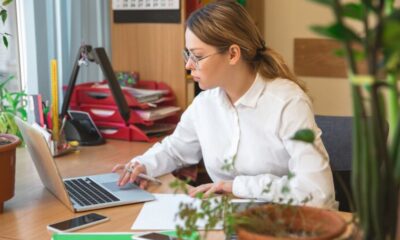BUSINESS
When Should a Business Outsource Hiring to Expert Recruiters?

In today’s dynamic job market, finding and securing top talent is more critical than ever for businesses striving to maintain a competitive edge.
According to Statista’s 2023 estimates, approximately 155.1 million Americans were employed, while 3.64% of the workforce remained unemployed. This marked the lowest unemployment rate since the 1950s, highlighting a tight labor market that posed significant challenges for employers.
However, these figures are expected to rise in the coming years, reflecting shifts in economic conditions and workforce trends.
While many organizations maintain internal recruiting teams, there are specific scenarios where outsourcing recruitment to expert headhunters can provide strategic advantages. Recognizing when to make this transition can play a pivotal role in driving a company’s growth and long-term success.
Signs Your Business Needs External Recruiting Support
Outsourcing your hiring needs can be a strategic move for your business. Here are some key indicators that it’s time to consider external recruiting support:
Rapid Growth and Scaling Challenges
During periods of rapid growth or expansion funding, internal HR teams often struggle to manage increased hiring demands. Expert recruiters can swiftly scale their efforts, leveraging specialized resources and established talent networks to expedite the hiring process.
According to CulverCareers, recruiting agencies navigate market nuances, allowing companies to bypass initial screening and move directly to the interview stage. They also extend their reach beyond traditional platforms like LinkedIn, Indeed, and Monster, effectively approaching more candidates in a passive market.
This targeted approach helps companies secure the right talent efficiently during critical growth phases.
Specialized Position Requirements
Organizations seeking candidates with rare skill sets or industry-specific expertise often benefit from external recruiters’ specialized networks. These professionals maintain extensive databases of qualified candidates and understand niche market dynamics, making them particularly valuable for hard-to-fill positions.
Limited Internal HR Resources
Small and medium-sized businesses may lack the infrastructure or expertise to handle complex recruiting needs. When internal teams are stretched thin or lack specific recruiting capabilities, external recruiters can provide immediate access to recruiting expertise.
Cost-Benefit Analysis of Outsourcing Recruitment
A thorough cost-benefit analysis is crucial when deciding whether to outsource recruitment. By carefully weighing the expenses and potential returns, businesses can make informed decisions that align with their strategic goals.
Direct and Indirect Cost Considerations
When evaluating recruitment strategies, businesses must look beyond the apparent fees charged by recruitment firms to understand the complete cost picture.
According to Grand View Research, the global recruitment process outsourcing market size reached USD 7.33 billion in 2022. It is projected to grow at a CAGR of 16.1% from 2023 to 2030, driven primarily by the need for effective recruiting processes and reduced overhead costs.
The hidden costs of maintaining internal recruitment operations can be substantial and often overlooked. These include ongoing expenses for posting job advertisements across multiple platforms, which can quickly accumulate, especially for high-volume hiring.
Additionally, there’s significant time investment required from hiring managers for resume screening and interviewing, taking them away from their core responsibilities.
Time-to-Hire Impact
Professional recruiters often reduce the time-to-hire metric significantly, which can translate to substantial cost savings. Faster placements mean less disruption to business operations and reduced interim staffing costs.
Key Benefits of Working with Expert Recruiters
Partnering with expert recruiters can significantly streamline your job search. Here are some key advantages:
Market Intelligence and Industry Insights
In a rapidly evolving job market, staying informed is key to effective talent acquisition.
According to Gartner, the changing demands for organizational skills require HR leaders to rethink their recruiting strategies. Professional recruiters bring valuable labor market intelligence, offering a clear view of cost, time, talent availability, competitiveness, and cultural fit.
Labor market intelligence goes beyond data trends, revealing insights about talent supply, candidate sourcing challenges, and competition rates. Recruiters provide crucial information on current salary expectations, compensation trends, available talent pools, and competitor hiring practices. Additionally, they highlight emerging skill sets and qualifications essential for future-proofing your workforce.
Expanded Reach to Passive Candidates
A key benefit of working with expert recruiters lies in their ability to access a pool of ‘passive’ candidates. These are highly skilled professionals who aren’t actively searching for new jobs but could be persuaded by the right opportunity.
According to TechTarget, a substantial 70% of the global workforce falls into the passive category, meaning they are not actively seeking jobs. This highlights the importance of reaching beyond the 30% who are actively job hunting.
Expert recruiters use their insights to effectively engage passive candidates, accessing a talent pool of top professionals in their fields.
Risk Mitigation
Professional recruiting firms often offer guarantees and replacement services if a placed candidate does not meet expectations within a specified timeframe. This is especially important for senior-level positions, where mis-hires can be extremely costly.
According to Forbes, two in three workers admit to realizing they were a bad fit after being hired. The financial impact of such mis-hires can be staggering. For instance, mis-hiring a sales representative with a $100,000 base salary can cost over $1 million when factoring in lost revenue.
With U.S. businesses losing a trillion dollars annually due to voluntary turnover, these guarantees serve as an essential safety net.
Best Practices for Working with Recruitment Firms
To achieve success when collaborating with recruitment firms, it is crucial to establish clear communication from the outset. First, provide detailed information about position requirements and qualifications to ensure that recruiters understand the specific skills and experience needed for the role.
Equally important is conveying your company culture and values, as this helps recruiters identify candidates who will fit well within your organization.
Additionally, outline compensation parameters to align expectations and attract suitable talent. Setting clear timeline expectations is essential for both parties to manage the recruitment process effectively and meet hiring deadlines.
Lastly, establish feedback mechanisms to facilitate ongoing communication throughout the hiring process. Regular feedback allows recruiters to adjust their search strategies based on your insights, ultimately leading to better candidate matches.
Frequently Asked Questions
Can outsourcing recruitment impact company culture?
Yes, outsourcing recruitment can impact company culture if external recruiters don’t fully understand the organization’s values, mission, and work environment. However, when done correctly, recruiters can attract candidates who align with the company culture by focusing on cultural fit, ensuring long-term success and retention.
How long does it typically take to see results when working with external recruiters?
Timeline expectations vary by position and market conditions, but professional recruiters typically present initial qualified candidates within 2-3 weeks. Complete placement cycles often range from 4-12 weeks, depending on the seniority and specialization of the role.
Can external recruiters help with international hiring?
Yes, many recruitment firms specialize in international placements and maintain global networks. They can provide valuable assistance with cross-border hiring, including insights into local labor laws, compensation norms, and cultural considerations.
The decision to outsource hiring to expert recruiters should be based on a careful analysis of your organization’s specific needs, resources, and growth objectives. While external recruiting partners can provide valuable expertise and efficiency, the choice isn’t always clear-cut. Consider your company’s size, growth rate, hiring complexity, and internal capabilities when making this decision.
The most successful approach often involves strategically combining internal and external recruiting resources to optimize your talent acquisition efforts.
BUSINESS
Common Legal Issues in Residential Real Estate and How to Address Them

Navigating residential real estate transactions can involve various legal challenges that homeowners and buyers should be aware of. Common issues include unclear property titles, zoning disputes, boundary disagreements, and contract misunderstandings. Addressing these matters proactively can prevent costly delays and protect all parties involved. Understanding the basics of real estate law helps individuals recognize potential pitfalls before they escalate into serious problems.
Engaging with professionals knowledgeable in real estate law can guide you in drafting contracts, resolving disputes, and ensuring compliance with local regulations. By seeking informed advice early, homeowners and buyers can reduce risk, streamline transactions, and safeguard their investments. Awareness and preparation are key to handling legal complexities effectively while maintaining confidence throughout the buying or selling process.
Title and Deed Fraud
Title fraud is a significant issue in which criminals transfer property ownership illegally by forging signatures or using other fraudulent means. This not only compromises ownership but may also leave you liable for debts or liens tied to your property. To protect your home, periodically monitor the status of your property title and consider using title lock services that can notify you of any unauthorized changes to your title. Title insurance, which most lenders require, also provides a crucial layer of protection for homeowners.
Undisclosed Property Defects
When selling property, sellers are legally obligated to disclose any known issues; however, some defects may remain hidden until after the sale has been completed. Commonly undisclosed issues include water damage, faulty wiring, and past pest infestations, which can result in significant costs for buyers. Buyers must conduct a thorough home inspection and scrutinize disclosure forms, maintaining clear communication with inspectors to document potential issues. If defects arise after the sale, buyers may have legal avenues for compensation or to rescind the contract.
Breach of Contract
Residential real estate deals are governed by contracts detailing every aspect of the transaction, from price and contingencies to required repairs and closing dates. Breaches can occur if any party fails to meet their obligations, for instance, by not repairing a leaky roof as promised or missing crucial deadlines. Preventing breaches begins with clear and precise language in contracts and diligent communication among all parties. Understanding residential real estate law is essential, as it provides the framework for enforcing agreements and resolving disputes. In the event of a potential contract violation, consulting with a real estate attorney can help explore remedies such as mediation, renegotiation, or pursuing damages through legal channels.
Financing and Mortgage Issues
Financing problems or misconceptions about mortgages, such as loan denials after an offer, misunderstandings about interest rates, and mistakes in documentation, can make a real estate transaction difficult. Before closing, buyers should maintain good credit, avoid making significant financial changes, and thoroughly understand their loan terms and conditions. To mitigate risks and prevent unforeseen issues, it is crucial to maintain open lines of communication with lenders, including documenting all conversations.
Zoning and Land Use Restrictions
Zoning laws regulate the use of properties, including structures, businesses, and fences. Ignoring local ordinances can lead to legal issues or the removal of modifications. Check the regulations on your city or county website and consult with planning officials before making changes to ensure compliance and avoid costly errors.
Homeowners Association (HOA) Disputes
Neighborhoods governed by HOAs come with additional rules and responsibilities. Disputes over landscaping, parking, noise, or architectural changes are common and can lead to fines or legal conflicts if not handled carefully. Before committing to a property in a managed community, scrutinize the HOA’s covenants, conditions, and restrictions (CC&Rs), and attend community meetings if possible. If you find yourself facing a dispute, approach your HOA board promptly and maintain a documented record of correspondence to facilitate quick and amicable resolutions.
Boundary and Survey Disputes
Accurate boundary identification is crucial for maintaining peaceful neighbor relationships and facilitating future transactions. Disputes may arise from misinterpreted property lines, encroachments, or unclear lot descriptions. Buyers should always order a fresh professional survey before closing and review all records for discrepancies. Resolving boundary disagreements amicably is ideal, but legal recourse may be necessary if talks fail. County assessor offices and historical deed records often provide valuable documentation during such disputes.
Conclusion
By proactively identifying and addressing these common legal issues in residential real estate, you reduce the likelihood of disputes and financial setbacks. Relying on professionals, including attorneys, inspectors, and local government officials, is crucial to navigating the process safely. Make informed decisions, keep diligent records, and stay current with your obligations to ensure a successful and secure real estate experience.
BUSINESS
The Power of Peace of Mind: Why Insurance Is an Investment, Not an Expense

Understanding Insurance as an Investment
Understanding insurance as an investment means recognizing that certain policies serve a dual purpose: offering financial protection and building long-term value. Unlike savings accounts, these policies create a safety net and accumulate cash value, like life insurance growing through interest or dividends, providing coverage and wealth buildup. Viewing insurance this way helps individuals choose policies aligned with their financial goals and risk tolerance. Even standard policies, such as auto insurance, contribute to financial planning by covering damages and liabilities, preventing major expenses that could affect budgets or investments. Recognizing insurance’s dual role as protection and potential investment allows for better financial stability and peace of mind.
Major Types of Insurance and Their Benefits
Each insurance type serves a specific purpose. Health insurance covers unexpected illnesses, providing lifesaving care when needed. Property and homeowner’s insurance help rebuild after fires or storms. Auto coverage protects your vehicle and passengers and fulfills legal requirements, shielding parties from losses. Policies can be customized with add-ons like identity theft or bundling car, house, or business liabilities to suit your needs. Home insurance is essential for homeowners, protecting against weather damage, theft, and liability, so you can rest easy. The right coverage considers your assets, lifestyle, and goals, building a safety net. When choosing insurance, look beyond premiums to the long-term impact of coverage.
The Economic Impact of Insurance on Communities
Insurance isn’t just about individual peace of mind; it fortifies entire communities. When people and businesses insure their property, health, and liabilities, they’re more likely to innovate, expand, and support local economies without the threat of catastrophic loss holding them back. In times of crisis, insurance payouts for rebuilding and recovery help stabilize neighborhoods and reduce the strain on public resources.
Economists have observed for a long time that insurance significantly supports entrepreneurship and investment in new ventures. Industries with good coverage tend to withstand economic downturns better and recover more quickly from unexpected shocks. Without the reassurance provided by insurance, growth and innovation would slow down considerably, and the potential risks might prevent significant advancements.
Integrating Insurance into Long-Term Financial Planning
Insurance should be a pillar of any sound financial plan. Start by assessing which risks could cause serious setbacks and match coverage types to those needs. For example, young families often prioritize life insurance for security, while property owners focus on home protection. Consistently reviewing policies ensures your protection evolves along with life changes, from family milestones to new business ventures.
Smart policyholders treat premiums as contributions toward future security—much like retirement savings or investments in education. This proactive mindset isn’t about compliance or mere obligation; it’s about wisely positioning yourself and your loved ones to weather whatever comes, while supporting the stability and prosperity of your broader community.
Conclusion
In today’s unpredictable world, the value of insurance extends far beyond a monthly bill. It is a critical investment, weaving together individual peace of mind with the collective strength of families, homeowners, and business owners. By embracing insurance as a strategic tool rather than an expense, you empower yourself to pursue your dreams and build a future fortified against life’s uncertainties.
Building your protection strategy now lays the groundwork for confidence, stability, and security—qualities that enrich not only your own life but also the broader community and economy. Make insurance a purposeful component of your financial plan and experience the freedom that comes from true peace of mind.
BUSINESS
IT Wordsearch: Redefining Modern Leadership and Purpose

In today’s rapidly evolving world, leadership is no longer defined solely by financial success or corporate expansion. The most influential leaders are those who integrate business excellence with social responsibility, building organizations that thrive while uplifting communities. One such emerging perspective in this landscape is IT wordsearch—a concept that symbolizes the search for meaning, alignment, and innovation in modern leadership.
This article explores how IT wordsearch represents more than a puzzle-like curiosity. It reflects a deeper leadership journey—one where purpose and performance align, where success is measured not only in profits but also in people, culture, and long-term impact.
What is IT Wordsearch?
At first glance, it wordsearch may sound like a simple activity: finding hidden words within a grid. Yet when applied to leadership and business, the phrase takes on a symbolic meaning. It suggests a process of discovery, alignment, and focus. Just as players search for hidden words, leaders must search for solutions, values, and strategies hidden within the complexity of today’s global challenges.
The idea resonates with professionals who believe that economic growth and positive social change are not mutually exclusive but deeply interconnected. Much like solving a wordsearch, success lies in recognizing patterns, connecting dots, and uncovering possibilities others may overlook.
A Leadership Philosophy Rooted in Discovery
At the heart of the it wordsearch philosophy is the belief that leadership is a continuous search for purpose. This approach emphasizes three core values:
- Empathy in leadership: Understanding the human side of business, from employees to customers.
- Sustainability: Ensuring long-term growth by balancing profitability with environmental and social responsibility.
- Collaboration: Building partnerships that amplify both business outcomes and community well-being.
This framework reflects a growing awareness that modern organizations do not exist in isolation. They are part of larger ecosystems where every decision has ripple effects. Leaders who embrace the it wordsearch mindset don’t just chase immediate wins—they uncover deeper value that sustains both business and society.
Bridging Business Growth with Social Impact
What makes the it wordsearch approach so powerful is its ability to link corporate success with community impact. Much like finding words hidden within a grid, leaders must look beyond the obvious to discover opportunities for shared growth.
Examples of this approach include:
- Workplace Culture: Designing inclusive, supportive environments that attract and retain diverse talent.
- Community Investment: Reinvesting resources into education, local initiatives, and social programs before they become urgent needs.
- Innovation for Good: Using technology to solve pressing challenges, from environmental sustainability to equitable access to services.
When these values are embedded into strategy, businesses create a virtuous cycle: strong companies nurture stronger communities, which in turn sustain future growth.
Influence in the Digital Age
The digital landscape has amplified the importance of acting with foresight. Just as a wordsearch reveals hidden connections, the digital world reveals opportunities for influence and innovation. Leaders today use platforms not only for visibility but also to inspire movements and conversations around responsible practices.
With it wordsearch as a guiding principle, leaders leverage digital tools to:
- Reach broad audiences with authentic messages.
- Engage younger generations who value transparency and inclusion.
- Inspire peers to adopt purpose-driven strategies.
In this sense, digital influence is no longer about self-promotion—it is about amplifying messages that shape industries and communities alike.
A Model for the Next Generation
The rise of it wordsearch as a metaphor for leadership aligns closely with the values of Millennials and Gen Z. Younger professionals increasingly seek role models who:
- Live authentically, aligning values with action.
- Promote diversity and equity, not as an afterthought but as a foundation.
- Think globally, addressing interconnected challenges such as climate change, inequality, and digital ethics.
These expectations highlight why it wordsearch resonates—it symbolizes the search for alignment in an often disjointed world. By embodying these principles, leaders position themselves not just as executives but as mentors and trailblazers.
Challenges in the Search
Like solving a difficult puzzle, applying the it wordsearch philosophy is not without challenges. Leaders face:
- Balancing short-term pressures with long-term commitments to purpose.
- Convincing traditional stakeholders of the measurable value of social responsibility.
- Navigating uncertainty in rapidly changing markets and technologies.
However, these challenges are also opportunities. Much like hidden words, solutions often lie just beneath the surface. Leaders who embrace curiosity and adaptability can turn obstacles into breakthroughs.
Why the Wordsearch Metaphor Matters
The metaphor of it wordsearch matters because it reflects the complexity of modern leadership. Success isn’t about finding a single answer; it’s about uncovering many interconnected solutions. A leader who can anticipate challenges, spot hidden opportunities, and align strategy with purpose is far better equipped to guide organizations through uncertainty.
This proactive mindset is essential in a world where reactive leadership often falls short. Waiting until challenges dominate headlines is too late. By searching for solutions early—before they are visible to all—leaders create lasting resilience.
Looking Ahead
As leadership continues to evolve, it wordsearch represents more than a clever metaphor. It is a call to action: to search for meaning, embrace complexity, and discover opportunities before they become urgent.
In a world where consumers, employees, and investors increasingly demand accountability, the leaders who succeed will be those who treat every challenge like a wordsearch puzzle—hidden with possibilities waiting to be uncovered.
The future belongs to leaders who see beyond profits, who connect performance with purpose, and who embrace the ongoing search for what truly matters. In the end, the most powerful leaders are those who uncover meaning not after the fact, but during the process—just as one finds words hidden in a puzzle grid.
-

 HEALTH2 years ago
HEALTH2 years agoIntegrating Semaglutide into Your Weight Loss Plan: A Practical Guide
-

 HOME IMPROVEMENT2 years ago
HOME IMPROVEMENT2 years agoHow to Choose the Perfect Neutral Area Rug for Every Room
-

 LAW1 year ago
LAW1 year agoTeenage Drivers and Car Accidents in California: Risks and Parental Liability
-

 CONSTRUCTION1 year ago
CONSTRUCTION1 year agoConstruction Site Safety Regulations in New York and Your Rights as a Worker
-

 LAW1 year ago
LAW1 year agoPost-Divorce Considerations in California: Modifications and Long-Term Planning
-

 HOME2 years ago
HOME2 years agoSandra Orlow: The Teen Model Who Captivated the Internet
-

 FINANCE1 year ago
FINANCE1 year agoDigital Asset Management in Florida Estate Planning
-

 FASHION2 years ago
FASHION2 years ago7 Celebrity-Inspired Elegant Summer Dresses For 2024






